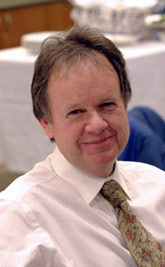

Friday - November 5, 2010
SLAC Today is
available online at:
http://today.slac.stanford.edu
In this issue:
From the Director of Photon Science: Building for the Future of Photon Science
X-Rays Offer First Detailed Look at Hotspots for Calcium-related Disease
In the News:
Cosmic Blast Hints at Inner Magnetar
Word of the Week: Random
 |
 |
|
Friday - November 5, 2010 |
From the Director of Photon Science: Building for the Future of Photon Science The Photon Science Directorate at SLAC continues to develop, with new science initiatives aligned with the Department of Energy and SLAC missions, and enabled by a growing and talented scientific workforce. Just in the past year, we have begun new efforts in materials and interfaces, led by Harold Hwang, and in catalysis, led by Jens Nørskov in the new Center for Sustainable Energy through Catalysis. Organizationally, these efforts fall within our Materials Sciences and Chemical Sciences Divisions, respectively. We are making plans for future expansion in additional areas, including the biosciences. SLAC's senior management and scientific workforce have developed a vision and plan for further growing the science we do at SLAC in our Photon Science Directorate. The SLAC Agenda and Annual Lab Plan are aligned with and support these goals. Much of the growth will come in fields that are experimental and will require modern laboratory space. We benefit tremendously from laboratory space on the Stanford University campus, associated with our materials science programs and involving a number of campus-based faculty and students. However, as the Photon Science Directorate grows significantly over the coming decade, we must accommodate an increasing level of experimental science on the SLAC campus if we are to achieve our long-range goals. So what is the plan to do this in the near and longer term? Read more... X-Rays Offer First Detailed Look at Hotspots for Calcium-related DiseaseHigh-resolution images of the ryanodine receptor, a protein associated with calcium-related disease, reveal in unprecedented detail the locations of more than 50 mutations that cluster in disease "hotspots" along the receptor. The grey portion of the above image represents low-resolution information about the entire receptor. The high-resolution structure is shown in blue, where each sphere represents a single atom. Mutations identified in individual amino acids are colored red. (Image courtesy of Filip Van Petegem/University of British Columbia.)
Calcium regulates many critical processes within the body, including muscle contraction, the heartbeat, and the release of hormones. But too much calcium can be a bad thing. In excess, it can lead to a host of diseases, such as severe muscle weakness, a fatal reaction to anesthesia or sudden cardiac death. Now, using intense X-rays from the Stanford Synchrotron Radiation Lightsource (SSRL) at the Department of Energy's SLAC National Accelerator Laboratory, researchers have determined the detailed structure of a key part of the ryanodine receptor, a protein associated with calcium-related disease. Their results, which combine data from SSRL and the Canadian Light Source, pinpoint the locations of more than 50 mutations that cluster in disease "hotspots” along the receptor. Read more... In the News:
|
Events
Access (see all)Announcements
|
|
| | ||
|
|
||
 <%
Response.AddHeader "Last-modified", getArticleDate()
'Response.AddHeader "Last-modified","Mon, 01 Sep 1997 01:03:33 GMT"
'Monday, December 06, 2010
%>
<%
Response.AddHeader "Last-modified", getArticleDate()
'Response.AddHeader "Last-modified","Mon, 01 Sep 1997 01:03:33 GMT"
'Monday, December 06, 2010
%>View online at http://today.slac.stanford.edu/. |
||